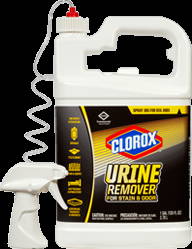 Cleanzine: your weekly cleaning and hygiene industry newsletter 25th April 2024 Issue no. 1111
Cleanzine: your weekly cleaning and hygiene industry newsletter 25th April 2024 Issue no. 1111
Your industry news - first
The original and best - for over 20 years!
We strongly recommend viewing Cleanzine full size in your web browser. Click our masthead above to visit our website version.
Cleaning industry professionals would rather tackle body fluids than urine stains and odours in washrooms, reveals survey
 Most people have a 'get in and get out' strategy when it comes to using public washrooms and do not consider what kind of maintenance is put into these facilities on a daily basis.
Most people have a 'get in and get out' strategy when it comes to using public washrooms and do not consider what kind of maintenance is put into these facilities on a daily basis.
With washroom maintenance likely to be a topic discussed at the ISSA/Intercleain conference in Orlando (the show ends tomorrow afternoon), Clorox Professional Products partnered with ISSA, to uncover the 'secrets from the stalls' and get the dirt about cleaning industry professionals' challenges and tough jobs in the washroom.
"Maintaining public restrooms is certainly a tough job, but it's also one of the most important tasks within a facility," argues Jennifer Case, associate director of marketing, Clorox Professional Products. "Not only do restrooms influence people's perceptions of the overall facility, but they also play a role in public health. Keeping a restroom disinfected can help prevent the spread of illness-causing germs to building occupants and the community at-large.
"This survey with ISSA allows us to further understand cleaning professionals' needs so that we can continue to develop innovative products and resources to help make their jobs easier."
Public washrooms can be found in all types of buildings, but no matter the setting, they all have similar cleaning and disinfecting needs. Above all, most cleaning industry professionals (67%) rank removing urine stains and odours as the most difficult cleaning and disinfecting task.[1] Other key findings include:
* Nearly half of professionals (49%) instruct their staff to remove urine stains and odours most often.1
* If all washrooms were self-cleaning, most respondents (61%) would love to never clean and disinfect urinals and toilets again.[1]
* Surprisingly, cleaning professionals rank cleaning up bodily fluids, such as blood and vomit, as more tolerable (43%) than removing urine stains and odours (56%).[1]
When it comes to public restrooms, cleaners have two important jobs: cleaning for appearance and cleaning for health. Maintaining a visibly clean washroom is important for influencing consumer perception, but harmful microorganisms, such as Shigella, Salmonella, Hepatitis A, E. coli and norovirus, are routinely found in washrooms and are associated with outbreaks of illness. [2],[3]
According to survey results, most (85%) are fully aware of the importance of this dual relationship of cleaning for appearance and health. The vast majority (95%) also believe that washroom cleaning has an impact on overall public health by helping to prevent the spread of disease.1
However, this understanding may not trickle down to all employees, as only half of respondents (49%) believe their employees are aware of all the risk associated with the spread of germs in the restroom.[1] The survey also found that:
* One in five respondents (20%) believe that the general public may think their facility's washroom harbours germs.[1]
* Most cleaning professionals believe that washroom handles harbour the most illness-causing germs and bacteria, particularly washroom door handles (65%), faucet handles (38%) and toilet or urinal handles (36%).[1]
* However, secondary research shows that this is false and that door handles pose the least risk for germs.[4] The feminine hygiene trash can, which only 12% of professionals believe to be germy,1 has one of the highest concentrations of germs.[5]
* Cleaning for aesthetics tasks are viewed as tougher than cleaning for health (disinfecting) tasks and only 29% of supervisors reported instructing their staff to disinfect surfaces most often.[1]
Keeping on top of washroom cleaning needs can be demanding, and although only 15% of respondents report a lack of education or training as a challenge to performing optimal restroom cleaning, far more (68%) say their employees do not understand or only somewhat understand the differences between cleaning, sanitising and disinfecting.[1]
Anthony Trombetta, director of sales, ISSA, says: "These survey results underscore some of the restroom cleaning challenges that are often neglected and show that industry professionals may not understand as much as they think they do.
"At ISSA, our goal is to arm our members with the knowledge and educational tools they need to help them perform their jobs optimally, and this survey endeavour with Clorox Professional allows us to gather valuable insights so that we can continue to fulfil that need."
When it comes to educational tools, cleaning professionals said the following:
Almost all (94%) rely on product usage instructions to train staff, but 43% of those think these tools could be improved.[1]
Nine in 10 (90%) professionals use restroom cleaning protocols or guidelines, but 45% believe these tools could be improved.[1]
[1] Clorox Professional Products Company and ISSA and ClearVoice Research. (May and June 2014). Cleaning Industry Professionals Public Restroom Survey. (Survey of 375 cleaning industry professionals).
[2] Barker J, Jones MV. "The potential spread of infection caused by aerosol contamination of surfaces after flushing a domestic toilet." Journal of Applied Microbiology 99(2005): 339-347.
[3] Boone SA, Gerba CP. "Significance of Fomites in the Spread of Respiratory and Enteric Viral Disease." Journal of Applied and Environmental Microbiology 73.6(2007): 1687-1696.
[4] "Restroom Germ Myths And Realities Revealed." CleanLink.com. (2013, June 13). Retrieved from: www.cleanlink.com
[5] Kravitz, R. "Restrooms: Where Are the Germs Really?" ISSA.com. (2009, Sept. 28). Retrieved from: www.issa.com
www.cloroxprofessional.com
6th November 2014







